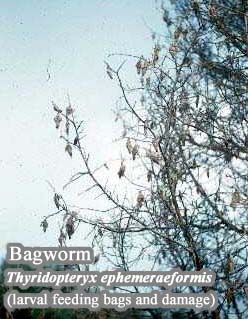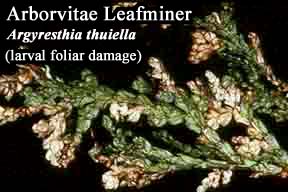Arborvitae (Thuja)
Plant Health Problems
Diseases caused by Physiological/Environmental Factors:
Winter injury.
A browning of the previous season's growth often shows on arborvitae, pine, and junipers in late winter or early spring due to drying winds or hot sun. Trees in exposed locations are more severely affected. This discoloration is due to evaporation of moisture from the leaves or needles faster than the roots can pick up water and is very apt to occur on newly transplanted trees. Browning may also be due to natural senescence of the previous season's growth.
Mulching and a thorough soaking of the ground around the trees before the ground freezes will help. Planting evergreens in protected places will prevent such drying. This reddish-brown discoloration of the tips of the branches should not be confused with the browning and dropping of the leaves or needles on the inside of the tree nearest the trunk. This leaf fall may take place in spring or fall and is a natural shedding of old leaves. Individual trees vary in this natural leaf-shedding: in some it may take place every year; in others every second or third year. For more information, see the fact sheet on Winter Injury on Woody Ornamentals.
Insect Problems
Aphids, Cinara tujafilina.
Aphids are soft-bodied, pear-shaped insects that feed in colonies, sucking sap from the stems, leaves and buds. The insects are brown and about 1/8" long. Among the compounds registered for control of this pest in Connecticut are malathion, insecticidal soap, imidacloprid or ultrafine horticultural oil. When needed during the growing season, sprays of malathion or insecticidal soap that contact the aphids will control them. Imidacloprid can be applied as a soil drench in early spring for systemic control. Dormant sprays of ultrafine horticultural oil will control overwintering insect eggs. Consult the label for dosage rates and safety precautions.
 Bagworm, Thyridopteryx ephemeraeformis.
Bagworm, Thyridopteryx ephemeraeformis.
The caterpillar lives in a silken cocoon or bag. Bits of leaves are attached to the outside of the bag. The caterpillar carries the bag with it as it feeds. A fully developed bag is about 2" long. Full-grown larvae pupate inside the bag, which the adult female moth never leaves. Male moths are black with clear wings that span one inch. Eggs are laid in the fall and hatch in May or June of the following year. A thorough application of Bacillus thuringiensis (Bt) var. kurstaki, malathion, or spinosad, applied soon after hatching, is effective. Consult the label for dosage rates and safety precautions. Hand picking bags may be practical in a small planting.
 Arborvitae leafminer, Argyresthia thuiella.
Arborvitae leafminer, Argyresthia thuiella.
The small greenish larva of this moth is a miner in the narrow leaflets of arborvitae and passes the winter in the mines. The injured leaves turn brown. The light gray moths emerge the last week of May and the first part of June, and lay eggs on the leaves. Eggs hatch about June 20, and the larvae begin mining the leaves. There is one generation each year. Shaded plants are more heavily infested. Among the compounds registered for control of this pest in Connecticut are acephate and imidacloprid. Acephate spray applied about May 15 will control larvae before they start mines. Monitor bushes in mid-August to see if any larvae have survived and are causing damage. Imidacloprid, applied as a soil drench in early spring, provides systemic, season-long control. Consult the label for dosage rates and safety precautions.
Arborvitae soft scale, Parthenolecanium fletcheri.
This is a small brown hemispherical scale occurring on arborvitae and yew. A dormant application of ultrafine horticultural oil can be applied to control overwintering nymphs. If needed, malathion, applied in late April, early July and early September should give good control. Imidacloprid, a restricted use insecticide applied as a soil drench by a licensed pesticide applicator, will provide season-long systemic control. Consult the labels for dosage rates and safety precautions.
Redcedar bark beetle, Phloeosinus dentatus.
This is a light brown or black beetle, 1/16" long, which excavates broad galleries under the bark, especially in stressed trees. If trees are kept in vigorous condition through adequate irrigation there will be little injury by this insect. Severely injured trees should be removed and either chipped or disposed of as municipal waste.
Smaller Japanese cedar longhorned beetle, Calidiellum rufipenne.
The smaller Japanese cedar longhorned beetle has been found boring in arborvitae in CT. It also attacks false cypress, juniper, and possibly other conifers. Adults are 3/8" to 1/2" long, blue gray in color, with antennae that curl like a handlebar mustache. Larvae bore in the hardwood of larger trunks. Split bark and dead branches are signs of this beetle. Applications of permethrin every three weeks during the flight period of adults can prevent egg-laying. Call the Station at 203-974-8474 to report sitings of this beetle. Follow this link for more information: Pest Alerts.
Spruce spider mite, Oligonychus ununguis.
Considerable injury is caused each season to conifers in ornamental plantings by the spruce spider mite, which feeds on the needles and webs them like twospotted spider mites. The trees take on a faded grayish or rusty brown appearance. Ultrafine horticultural oil, which is among the compounds registered for use against this pest in Connecticut, sprayed during the dormant season will control the overwintering eggs. The same material, applied during the growing season at 1/2 to 1%, effectively suppresses spider mites, while not eliminating beneficial predatory mites. Consult the label for dosage rates and safety precautions.
Strawberry root weevil, Otiorhynchus ovatus.
The larvae of this weevil often injure arborvitae plants in nurseries and ornamental plantings by feeding on the roots. The grubs devour the small roots and gnaw the bark from the larger roots, but unlike the closely related black vine weevils, rarely girdle plants. Adult feeding often encircles arborvitae twigs, which then may be left hanging on the tree to die and turn brown. The 1/3" long adult weevil is dark brown, with a short snout. Only females are known, and the adults are flightless. The legless grub is white with a brown head and is curved like grubs of other weevils. Adults and large larvae overwinter, emerging from May - July. The adults have to feed for 3-4 weeks before being able to lay eggs. Acephate and fluvalinate are among the compounds registered for control of this pest in Connecticut, and can be applied when adults feed and before they start laying eggs. The usual timing for these foliar sprays is during May, June and July at three week intervals. Insecticide resistance is very common; be aware that adults may appear to be dead following contact with fluvalinate, but may recover from poisoning within a few days. Consult the label for dosage rates and safety precautions. Treating the soil with insect pathogenic nematodes may control the larvae.

